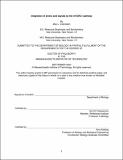Integration of amino acid signals by the mTORC1 pathway
Author(s)
Valenstein, Max L.
DownloadThesis PDF (40.22Mb)
Advisor
Cheeseman, Iain M.
Terms of use
Metadata
Show full item recordAbstract
To regulate growth, cells must integrate a broad array of environmental cues to coordinate anabolic and catabolic processes. The mechanistic target of rapamycin complex 1 (mTORC1) kinase pathway is the primary eukaryotic pathway responsible for integrating these diverse signals and coordinating cell growth programs. When activated by environmental cues that favors cell and organismal growth, mTORC1 phosphorylates substrates to promote anabolic programs, such as protein synthesis, and inhibit catabolic programs including autophagy. Aberrant mTORC1 signaling has been implicated in a variety of human disease states including cancer, diabetes, and epilepsy as well as normal physiological processes such as aging. Accordingly, the molecular basis for mTORC1 activation is of significant fundamental and pathophysiological interest.
Nutrients, such as amino acids and glucose, are critical mTORC1 activators that signal through the heterodimer Rag GTPases. When nutrients are abundant, the Rag GTPases recruit mTORC1 to the lysosome for activation. Several multi-protein complexes, including the antagonistic GATOR1 and GATOR2 complexes, control the Rag GTPases and are themselves regulated by nutrient sensors, which detect the presence or absence of specific metabolites. While the function of the GATOR1 complex has been reveled, GATOR2 remains enigmatic despite its essential role as an integrator of nutrient signals that promotes mTORC1 activation. This thesis describes a structural and biochemical characterization of the GATOR2 complex, which sheds light on its role in the mTORC1 signaling pathway. We used cryo-electron microscopy to determine the three-dimensional structure of GATOR2 and revealed that it forms a large, cage-like architecture formed by a novel mode of interaction between zinc-binding domains. The oligomeric scaffold of GATOR2 is decorated by WD40 β-propellers, which interact with nutrient sensors and the GATOR1 complex. These results suggest a model in which dynamic and competitive protein-protein interactions, and not ubiquitin transfer, transduce amino acid signals to mTORC1. This work provides a foundation for understanding the critical, integrative role that GATOR2 plays in the regulation of mTORC1 activation.
Date issued
2022-09Department
Massachusetts Institute of Technology. Department of BiologyPublisher
Massachusetts Institute of Technology